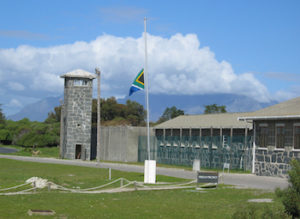
Robben Island Facility
*Robben Island was established on this date in 1448. Robben Island is a roughly oval landmass in Table Bay, 4.3 miles west of the coast of Bloubergstrand, north of Cape Town, South Africa.
It is a former maximum-security prison used by Dutch and British colonizers during the apartheid regime. It takes its name from the Dutch word for seals, hence the Dutch/Afrikaans name, which translates to Seal(s) Island. Bartolomeu Dias discovered the island in 1488. For many years, it was used by Portuguese slave traders during the Middle Passage and later by the English and Dutch as a refueling station.
In 1654, the Dutch Cape Colony settlers placed all their sheep and a few rams on Robben Island; the men built a large shed and shelter. The isolation offered better protection against wild animals than on the mainland. The settlers also collected seal skins and boiled oil to supply the needs of the settlement. Since the end of the 17th century, Robben Island has been used to incarcerate chiefly political prisoners. The Dutch settlers were the first to use Robben Island as a prison. Its first prisoner was probably in the mid-17th century. Among its early permanent inhabitants were political leaders imprisoned in other Dutch colonies.
After the British captured several Dutch East Indiamen in 1781, the Dutch moved prisoners to Saldanha Bay. In 1806, a whaling station opened at a sheltered bay on the island's northeastern shore, Murray's Bay. After a failed uprising in 1819, the fifth of the Xhosa Wars, the British colonial government sentenced African leader Makanda Nxele to life imprisonment on the island. He drowned on the shores of Table Bay after escaping from prison.
Starting in 1845, lepers were moved to Robben Island. In April 1891, the cornerstones for 11 new buildings to house lepers were laid. After the passage of the Leprosy Repression Act in May 1892, admission was no longer voluntary, and the movement of the lepers was restricted. Doctors and scientists did not understand the disease and thought isolation was the only way to prevent other people from contracting it. Before 1892, an average of about 25 lepers a year were admitted to Robben Island, but in 1892 that number rose to 338, and in 1893 a further 250 were admitted.
From 1961, Robben Island was used by the South African government as a prison for political prisoners and convicted criminals. In 1969, the Moturu Kramat, now a sacred site for Muslim pilgrimage on Robben Island, was built to commemorate Sayed Abdurahman Moturu, the Prince of Madura. Moturu, one of Cape Town's first imams, had been exiled to the island in the mid-1740s. He died there in 1754. Political activist Nelson Mandela was imprisoned on the island for 18 of the 27 years he served before the fall of apartheid and the introduction of full, multi-racial democracy. Other former inmates of Robben Island include Walter Sisulu, Kgalema Motlanthe, Govan Mbeki, and Jacob Zuma.
In 1982, former inmate Indres Naidoo's book "Island in Chains" became the first published account of prison life on the island. The maximum-security prison for political prisoners closed in 1991, and the medium-security prison for criminal prisoners closed five years later. With the end of apartheid, the island has become a popular tourist destination. Robben Island is a South African National Heritage Site and a UNESCO World Heritage Site.
It is managed by Robben Island Museum (RIM); in 1999, the island was declared a World Heritage Site for its importance to South Africa's political history and development of a democratic society. Thousands of visitors take the ferry from the Victoria & Alfred Waterfront in Cape Town every year to tour the island and its former prison. Many of the guides are former prisoners. All land on the island is owned by the nation of South Africa, except for the island church. Administratively, Robben Island is a suburb of the City of Cape Town. It is open all year round, weather permitting.